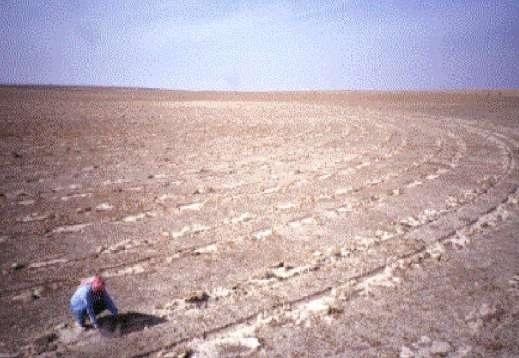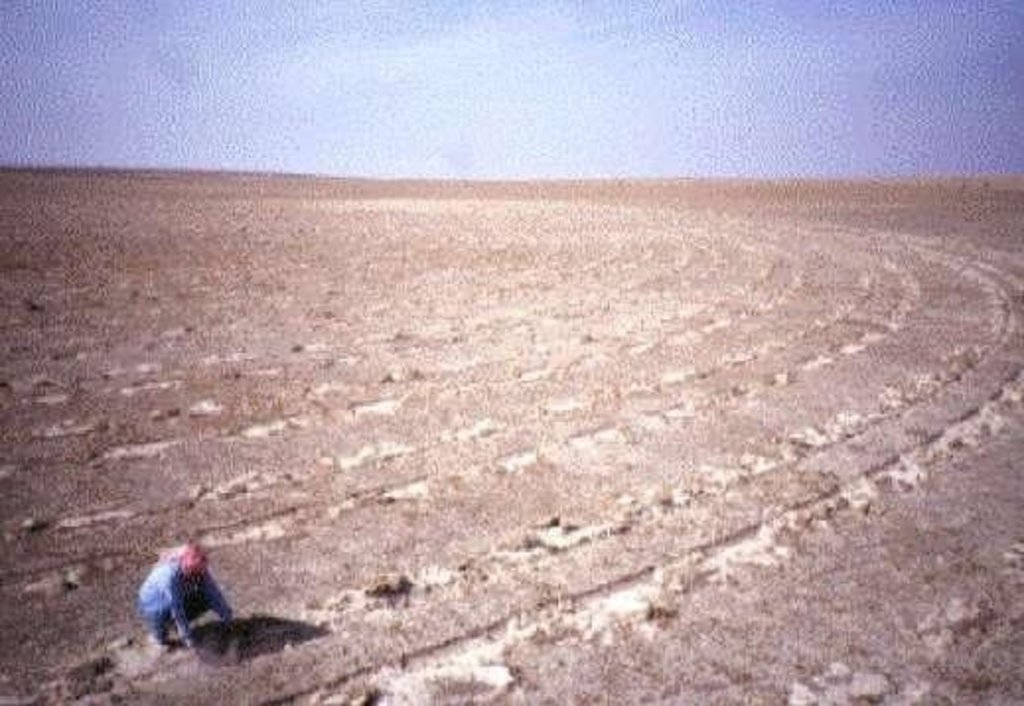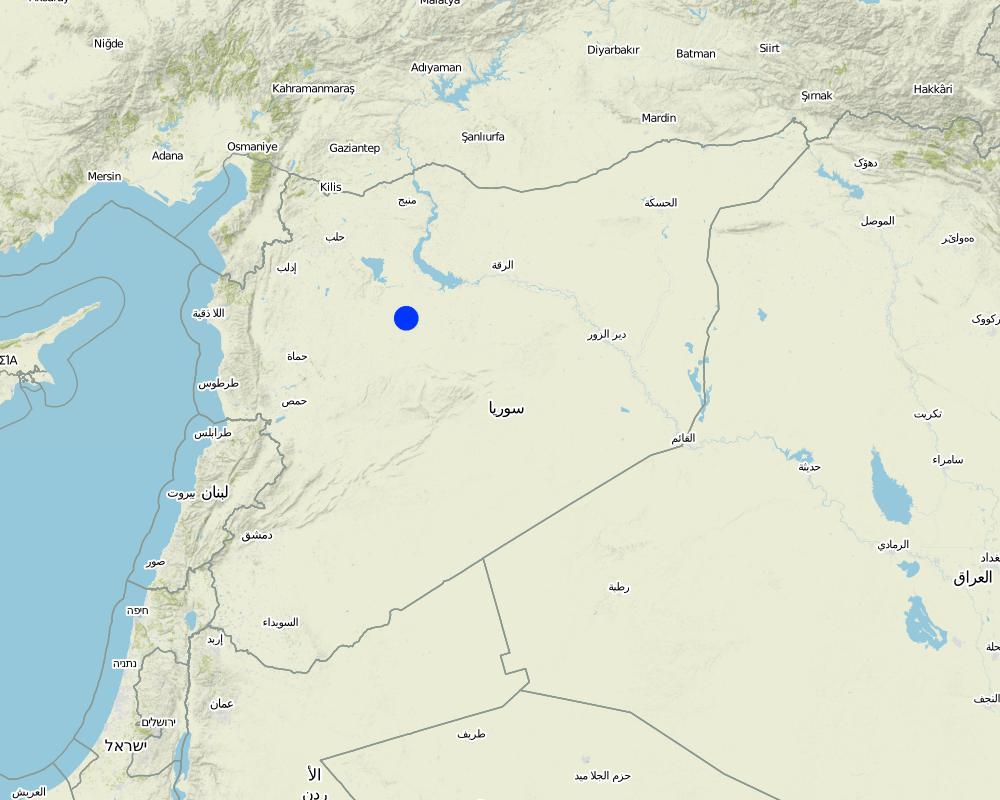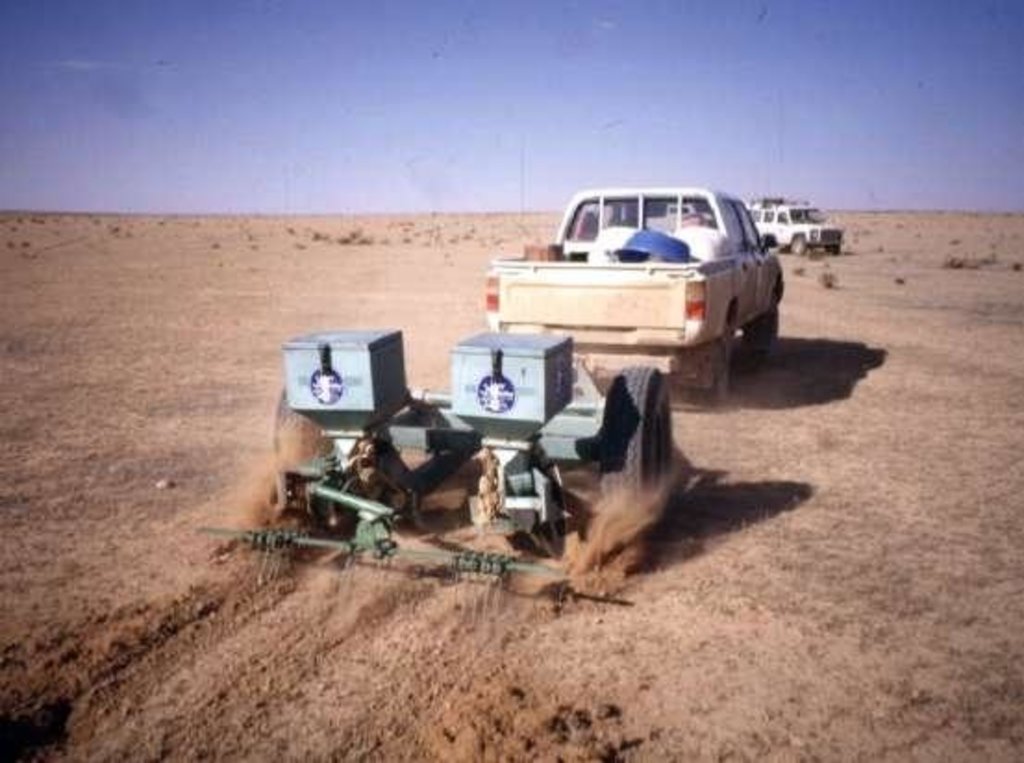Range Pitting and Reseeding [ซีเรีย]
- ผู้สร้างสรรค์:
- การอัพเดท:
- ผู้รวบรวม: Fahim Ghassali
- ผู้เรียบเรียง: –
- ผู้ตรวจสอบ: Fabian Ottiger, Alexandra Gavilano
Nakr al mara
technologies_1410 - ซีเรีย
ดูส่วนย่อย
ขยายทั้งหมด ย่อทั้งหมด1. ข้อมูลทั่วไป
1.2 รายละเอียดที่ติดต่อได้ของผู้รวบรวมและองค์กรที่เกี่ยวข้องในการประเมินและการจัดเตรียมทำเอกสารของเทคโนโลยี
ผู้เชี่ยวชาญ SLM:
Bathika Nabil
ICARDA
ซีเรีย
ผู้เชี่ยวชาญ SLM:
Gintzburger Gustave
Institut de Botanique -Univ. Louis Pasteur
ฝรั่งเศส
ผู้เชี่ยวชาญ SLM:
Hill Stephen
Australian Revegetation Corporation Ltd.
ออสเตรเลีย
ชื่อขององค์กรซึ่งอำนวยความสะดวกในการทำเอกสารหรือการประเมินเทคโนโลยี (ถ้าเกี่ยวข้อง)
International Center for Agricultural Research in the Dry Areas (ICARDA) - เลบานอนชื่อขององค์กรซึ่งอำนวยความสะดวกในการทำเอกสารหรือการประเมินเทคโนโลยี (ถ้าเกี่ยวข้อง)
Université de Strasbourg (UNISTRA) - ฝรั่งเศสชื่อขององค์กรซึ่งอำนวยความสะดวกในการทำเอกสารหรือการประเมินเทคโนโลยี (ถ้าเกี่ยวข้อง)
Australian Revegetation Corporation Ltd - ออสเตรเลีย1.3 เงื่อนไขการใช้ข้อมูลที่ได้บันทึกผ่านทาง WOCAT
ผู้รวบรวมและวิทยากรหลักยอมรับเงื่อนไขเกี่ยวกับการใช้ข้อมูลที่ถูกบันทึกผ่านทาง WOCAT:
ใช่
1.5 Reference to Questionnaire(s) on SLM Approaches (documented using WOCAT)
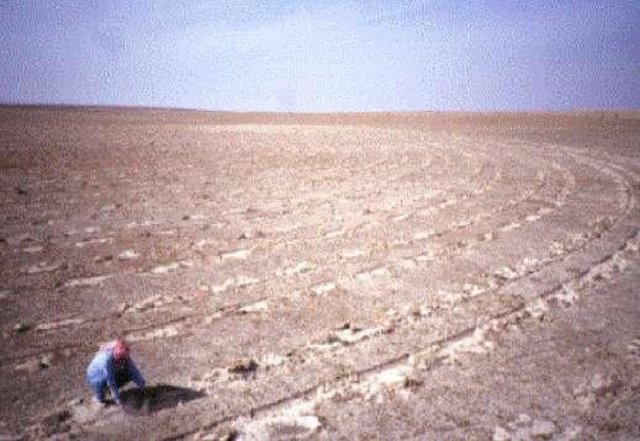
Government assisted rangeland rehabilitation [ซีเรีย]
The rehabilitation of overgrazed and denuded rangeland with government intervention
- ผู้รวบรวม: Unknown User
2. การอธิบายลักษณะของเทคโนโลยี SLM
2.2 การอธิบายแบบละเอียดของเทคโนโลยี
คำอธิบาย:
This technique is used to restore degraded rangelands (steppe areas) in the 150-200 mm rainfall zone in Syria. The technique is based on the pitting technique developed in Australia using the 'Camel Pitter' implement. The implement an be towed by an ordinary 2-wheel-drive pickup. Small ahallow 'pits' are scooped out by the action of inclined metal disks (similar to the disks of a disk plough). A seed hopper mounted on the top of the implement releases small quantities of range-plant seeds into the pits and an attached light harrow coveres the seeds with a thin layer of loose topsoil. The implement can also be used without the seeding device. The pits are usually made at the beginning ot just before the rainy season. In the soops made by the implement, rainwater collects and increases the soil moisture storage in and around the pits. On extremely shallow soils, pitting is not recommended because it removes the very top layer of soil and organic surface material and may expose the infertile subsoil. Seeds which emerge in the pits find favourable conditions for emergence and growth. During the early growth stages, the young plants are also sheltered by the pits from wind. The pitting machine should be pulled along the contour to optimize the capture of rainfall. Experience has shown that treating just 10-20 % of the area is sufficient to reestablish a 'starter vegetation' on completely denuded rangeland. In Syria, ARTEMISIA and SALSOLA species have been used successfully for rangeland reseeding. If used without the seeder, the pits will assist the reestablishment of the natural vegetation by providing sheltered and moist sites for seed emergence. To assure optimum reestablishment of vegetation, grazing should be controlled during the initial establishment phase.
2.3 รูปภาพของเทคโนโลยี
2.5 ประเทศภูมิภาค หรือสถานที่ตั้งที่เทคโนโลยีได้นำไปใช้และได้รับการครอบคลุมโดยการประเมินนี้
ประเทศ:
ซีเรีย
ภูมิภาค/รัฐ/จังหวัด:
Aleppo Province
ข้อมูลจำเพาะเพิ่มเติมของสถานที่ตั้ง :
Obisan, Dalbouh
แสดงความคิดเห็น:
Comments:
Total area covered by the SLM Technology is 110 km2.
The main collaborator was the Ministry of Agriculture (Steppe Directorate)
Map
×2.6 วันที่การดำเนินการ
ถ้าไม่รู้ปีที่แน่นอน ให้ระบุวันที่โดยประมาณ:
- น้อยกว่า 10 ปี (ไม่นานนี้)
2.7 คำแนะนำของเทคโนโลยี
ให้ระบุว่าเทคโนโลยีถูกแนะนำเข้ามาอย่างไร:
- ทางโครงการหรือจากภายนอก
ความคิดเห็น (ประเภทของโครงการ เป็นต้น) :
Western Australia
3. การจัดประเภทของเทคโนโลยี SLM
3.1 วัตถุประสงค์หลักของเทคโนโลยี
- ลด ป้องกัน ฟื้นฟู การเสื่อมโทรมของที่ดิน
3.2 ประเภทของการใช้ที่ดินในปัจจุบันที่ได้นำเทคโนโลยีไปใช้

ทุ่งหญ้าเลี้ยงสัตว์
Extensive grazing:
- การเลี้ยงสัตว์แบบเร่ร่อนไปตามที่ต่าง ๆ (Nomadism)
แสดงความคิดเห็น:
Major land use problems (compiler’s opinion): Overgrazing and cutting of woody shrubs for firewood. Large-scale cultivation of fodder barley (for grazing) completely removes the natural vegetation.
Major land use problems (land users’ perception): The land tenure system. Rangeland is 'public land' and control over its use is difficult to implement.
locally adapted rareseedinspecies, e.g., Atriplex halimus, Salsola vermiculata, Artemisia herba-alba
3.5 กลุ่ม SLM ที่ตรงกับเทคโนโลยีนี้
- การปรับปรุงดิน / พืชคลุมดิน
3.6 มาตรการ SLM ที่ประกอบกันเป็นเทคโนโลยี
3.7 รูปแบบหลักของการเสื่อมโทรมของที่ดินที่ได้รับการแก้ไขโดยเทคโนโลยี

การกัดกร่อนของดินโดยลม
- Et (Loss of topsoil): การสูญเสียดินชั้นบน

การเสื่อมโทรมของน้ำ
- Ha (Aridification): การเกิดความแห้งแล้ง
แสดงความคิดเห็น:
Main type of degradation addressed: Et: loss of topsoil, Ha: aridification
Main causes of degradation: overgrazing (Too many animals. Grazing pressure is too high), Over-exploitation of vegetation (Too many animals. Grazing pressure is too high), Land subdivision (Land parcels for communities are limited in size)
3.8 การป้องกัน การลดลง หรือการฟื้นฟูความเสื่อมโทรมของที่ดิน
ระบุเป้าหมายของเทคโนโลยีกับความเสื่อมโทรมของที่ดิน:
- ป้องกันความเสื่อมโทรมของที่ดิน
- ฟื้นฟูบำบัดที่ดินที่เสื่อมโทรมลงอย่างมาก
4. ข้อมูลจำเพาะด้านเทคนิค กิจกรรมการนำไปปฏิบัติใช้ ปัจจัยนำเข้า และค่าใช้จ่าย
4.1 แบบแปลนทางเทคนิคของเทคโนโลยี
ข้อมูลจำเพาะด้านเทคนิค (แบบแปลนทางเทคนิคของเทคโนโลยี):
Technical knowledge required for field staff / advisors: high
Technical knowledge required for land users: low
Main technical functions: improvement of ground cover, increase / maintain water stored in soil, water harvesting
Vegetative measure: pitting: scooping out very shallow pits
Vegetative material: O : other, O : other
Vegetative measure: Vegetative material: O : other, O : other
Vegetative measure: Vegetative material: O : other, O : other
Vegetative measure: Vegetative material: O : other, O : other
Other species: locally adapted rareseedinspecies, e.g., Atriplex halimus, Salsola vermiculata, Artemisia herba-alba
Gradient along the rows / strips: 0.00%
4.2 ข้อมูลทั่วไปเกี่ยวกับการคำนวณปัจจัยนำเข้าและค่าใช้จ่าย
อื่นๆ หรือสกุลเงินประจำชาติ (ระบุ):
Syrian Pound
If relevant, indicate exchange rate from USD to local currency (e.g. 1 USD = 79.9 Brazilian Real): 1 USD =:
50.0
ระบุค่าเฉลี่ยของค่าจ้างในการจ้างแรงงานต่อวัน:
4.00
4.3 กิจกรรมเพื่อการจัดตั้ง
| กิจกรรม | Timing (season) | |
|---|---|---|
| 1. | pitting | beginning of the rainy season |
4.4 ค่าใช้จ่ายของปัจจัยนำเข้าที่จำเป็นสำหรับการจัดตั้ง
| ปัจจัยนำเข้า | หน่วย | ปริมาณ | ค่าใช้จ่ายต่อหน่วย | ค่าใช้จ่ายทั้งหมดต่อปัจจัยนำเข้า | %ของค่าใช้จ่ายที่ก่อให้เกิดขึ้นโดยผู้ใช้ที่ดิน | |
|---|---|---|---|---|---|---|
| แรงงาน | Labour | ha | 1.0 | 120.0 | 120.0 | 100.0 |
| อุปกรณ์ | Machine use | ha | 1.0 | 960.0 | 960.0 | 10.0 |
| วัสดุด้านพืช | Seeds | ha | 1.0 | 270.0 | 270.0 | |
| วัสดุสำหรับก่อสร้าง | Sand | ha | 1.0 | 1.0 | 1.0 | |
| ค่าใช้จ่ายทั้งหมดของการจัดตั้งเทคโนโลยี | 1351.0 | |||||
| Total costs for establishment of the Technology in USD | 27.02 | |||||
แสดงความคิดเห็น:
Duration of establishment phase: 12 month(s)
4.5 การบำรุงรักษาสภาพหรือกิจกรรมที่เกิดขึ้นเป็นประจำ
| กิจกรรม | ช่วงระยะเวลา/ความถี่ | |
|---|---|---|
| 1. | pitting | beginning of the rainy season /annually where plants have not come up |
4.6 ค่าใช้จ่ายของปัจจัยนำเข้าและกิจกรรมที่เกิดขึ้นเป็นประจำที่ต้องการการบำรุงรักษา (ต่อปี)
| ปัจจัยนำเข้า | หน่วย | ปริมาณ | ค่าใช้จ่ายต่อหน่วย | ค่าใช้จ่ายทั้งหมดต่อปัจจัยนำเข้า | %ของค่าใช้จ่ายที่ก่อให้เกิดขึ้นโดยผู้ใช้ที่ดิน | |
|---|---|---|---|---|---|---|
| แรงงาน | Labour | ha | 1.0 | 12.0 | 12.0 | 100.0 |
| อุปกรณ์ | Machine use | ha | 1.0 | 96.0 | 96.0 | 10.0 |
| วัสดุด้านพืช | Seeds | ha | 1.0 | 9.0 | 9.0 | 3.0 |
| ค่าใช้จ่ายทั้งหมดของการบำรุงรักษาสภาพเทคโนโลยี | 117.0 | |||||
| Total costs for maintenance of the Technology in USD | 2.34 | |||||
แสดงความคิดเห็น:
per ha of treated area
4.7 ปัจจัยสำคัญที่สุดที่มีผลกระทบต่อค่าใช้จ่าย
ปัจจัยสำคัญที่สุดที่มีผลกระทบต่อค่าใช้จ่ายต่างๆ:
labour, slope, soil depth
5. สิ่งแวดล้อมทางธรรมชาติและของมนุษย์
5.1 ภูมิอากาศ
ฝนประจำปี
- < 250 ม.ม.
- 251-500 ม.ม.
- 501-750 ม.ม.
- 751-1,000 ม.ม.
- 1,001-1,500 ม.ม.
- 1,501-2,000 ม.ม.
- 2,001-3,000 ม.ม.
- 3,001-4,000 ม.ม.
- > 4,000 ม.ม.
ข้อมูลจำเพาะ/ความคิดเห็นเรื่องปริมาณน้ำฝน:
Dryland area with 150-180 mm rain
เขตภูมิอากาศเกษตร
- แห้งแล้ง
Area not suitable for arable farming
5.2 สภาพภูมิประเทศ
ค่าเฉลี่ยความลาดชัน:
- ราบเรียบ (0-2%)
- ลาดที่ไม่ชัน (3-5%)
- ปานกลาง (6-10%)
- เป็นลูกคลื่น (11-15%)
- เป็นเนิน (16-30%)
- ชัน (31-60%)
- ชันมาก (>60%)
ธรณีสัณฐาน:
- ที่ราบสูง/ที่ราบ
- สันเขา
- ไหล่เขา
- ไหล่เนินเขา
- ตีนเนิน
- หุบเขา
ระดับความสูง:
- 0-100 เมตร
- 101-500 เมตร
- 501-1,000 เมตร
- 1,001-1,500 เมตร
- 1,501-2,000 เมตร
- 2,001-2,500 เมตร
- 2,501-3,000 เมตร
- 3,001-4,000 เมตร
- > 4,000 เมตร
ความคิดเห็นและข้อมูลจำเพาะเพิ่มเติมเรื่องสภาพภูมิประเทศ:
Slopes on average: Flat (flat areas prone to wind erosion)
5.3 ดิน
ค่าเฉลี่ยความลึกของดิน:
- ตื้นมาก (0-20 ซ.ม.)
- ตื้น (21-50 ซ.ม.)
- ลึกปานกลาง (51-80 ซ.ม.)
- ลึก (81-120 ซ.ม.)
- ลึกมาก (>120 ซ.ม.)
เนื้อดิน (ดินชั้นบน):
- ปานกลาง (ดินร่วน ทรายแป้ง)
อินทรียวัตถุในดิน:
- ต่ำ (<1%)
5.6 ลักษณะของผู้ใช้ที่ดินที่นำเทคโนโลยีไปปฏิบัติใช้
รายได้ที่มาจากนอกฟาร์ม:
- 10-50% ของรายได้ทั้งหมด
ระดับของความมั่งคั่งโดยเปรียบเทียบ:
- ยากจนมาก
ระบุลักษณะอื่นๆที่เกี่ยวข้องของผู้ใช้ที่ดิน:
Population density: < 10 persons/km2
Annual population growth: 2% - 3%
100% of the land users are poor.
Off-farm income specification: migrant work
5.7 Average area of land used by land users applying the Technology
- < 0.5 เฮกตาร์
- 0.5-1 เฮกตาร์
- 1-2 เฮกตาร์
- 2-5 เฮกตาร์
- 5-15 เฮกตาร์
- 15-50 เฮกตาร์
- 50-100 เฮกตาร์
- 100-500 เฮกตาร์
- 500-1,000 เฮกตาร์
- 1,000-10,000 เฮกตาร์
- >10,000 เฮกตาร์
5.8 กรรมสิทธิ์ในที่ดิน สิทธิในการใช้ที่ดินและสิทธิในการใช้น้ำ
กรรมสิทธิ์ในที่ดิน:
- รัฐ
สิทธิในการใช้ที่ดิน:
- เกี่ยวกับชุมชน (ถูกจัดระเบียบ)
6. ผลกระทบและสรุปคำบอกกล่าว
6.1 ผลกระทบในพื้นที่ดำเนินการ (On-site) จากการใช้เทคโนโลยี
ผลกระทบทางด้านเศรษฐกิจและสังคม
การผลิต
คุณภาพพืชที่ใช้เลี้ยงปศุสัตว์
การผลิตสัตว์
รายได้และค่าใช้จ่าย
รายได้จากฟาร์ม
ผลกระทบด้านสังคมวัฒนธรรมอื่น ๆ
การบรรเทาความขัดแย้ง
ผลกระทบด้านนิเวศวิทยา
วัฐจักรน้ำหรือน้ำบ่า
น้ำไหลบ่าที่ผิวดิน
จำนวนก่อน SLM:
45
หลังจาก SLM:
5
ดิน
ความชื้นในดิน
สิ่งปกคลุมดิน
การสูญเสียดิน
จำนวนก่อน SLM:
4
หลังจาก SLM:
1
การหมุนเวียนและการเติมของธาตุอาหาร
ความหลากหลายทางชีวภาพของพืชและสัตว์
ความหลากหลายทางชีวภาพของพืช
ความหลากหลายทางชีวภาพของสัตว์
แสดงความคิดเห็น/ระบุ:
Improvement of wildlife
ความหลากหลายของสัตว์
ลดความเสี่ยงของภัยพิบัติ
ความเร็วของลม
6.2 ผลกระทบนอกพื้นที่ดำเนินการ (Off-site) จากการใช้เทคโนโลยี
Natural seed multiplication and supply
6.4 การวิเคราะห์ค่าใช้จ่ายและผลประโยชน์ที่ได้รับ
ผลประโยชน์ที่ได้รับเปรียบเทียบกับค่าใช้จ่ายในการจัดตั้งเป็นอย่างไร (จากมุมมองของผู้ใช้ที่ดิน)
ผลตอบแทนระยะสั้น:
เป็นกลางหรือสมดุล
ผลตอบแทนระยะยาว:
ด้านบวก
ผลประโยชน์ที่ได้รับเปรียบเทียบกับค่าใช้จ่ายในการบำรุงรักษาหรือต้นทุนที่เกิดขึ้นซ้ำอีก เป็นอย่างไร (จากมุมมองของผู้ใช้ที่ดิน)
ผลตอบแทนระยะสั้น:
เป็นกลางหรือสมดุล
ผลตอบแทนระยะยาว:
ด้านบวกอย่างมาก
6.5 การปรับตัวของเทคโนโลยี
แสดงความคิดเห็น:
100% of land user families have adopted the Technology with external material support
50 land user families have adopted the Technology with external material support
Comments on acceptance with external material support: survey results
Comments on spontaneous adoption: survey results
There is no trend towards spontaneous adoption of the Technology
Comments on adoption trend: The land belongs to the state and not to the land users
6.7 จุดแข็ง / ข้อได้เปรียบ / โอกาสของเทคโนโลยี
| จุดแข็ง / ข้อได้เปรียบ / โอกาสในทัศนคติของผู้ใช้ที่ดิน |
|---|
|
Better vegetation growth How can they be sustained / enhanced? More involvement of the local community. Pay attention to land-use rights and land ownership |
|
Better feed resource How can they be sustained / enhanced? More involvement of the local community. Pay attention to land-use rights and land ownership |
| จุดแข็ง / ข้อได้เปรียบ / โอกาสในทัศนคติของผู้รวบรวมหรือวิทยากรหลัก |
|---|
|
cost-effective way to revegetate denuded rangeland How can they be sustained / enhanced? Protection from grazing for the first 3 years |
|
Increased range productivity How can they be sustained / enhanced? Better regulated grazing of the vegetation. Preventing overgrazing |
6.8 จุดอ่อน / ข้อเสียเปรียบ / ความเสี่ยงของเทคโนโลยีและวิธีการแก้ไข
| จุดอ่อน / ข้อเสียเปรียบ / ความเสี่ยงในทัศนคติของผู้รวบรวมหรือวิทยากรหลัก | มีวิธีการแก้ไขได้อย่างไร |
|---|---|
| The pitting machine removes the top 5 cm of soil and the vegetation over the area of the pit | Method should not be used on extremely shallow soils |
7. การอ้างอิงและการเชื่อมต่อ
7.1 วิธีการและแหล่งข้อมูล
ลิงก์และโมดูล
ขยายทั้งหมด ย่อทั้งหมดลิงก์

Government assisted rangeland rehabilitation [ซีเรีย]
The rehabilitation of overgrazed and denuded rangeland with government intervention
- ผู้รวบรวม: Unknown User
โมดูล
ไม่มีโมดูล


